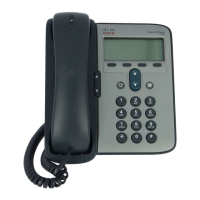Chapter 9 Troubleshooting and Maintenance
Monitoring the Voice Quality of Calls
9-22
Cisco Unified IP Phone 7906G and 7911G Administration Guide for Cisco Unified CallManager 5.1
OL-11515-01
It is important to distinguish significant changes from random changes in metrics.
Significant changes are scores that change about 0.2 MOS or greater and persist
in calls that last longer than 30 seconds. Conceal Ratio changes should indicate
greater than 3 percent frame loss.
MOS LQK scores can vary based on the codec that the Cisco Unified IP Phone
uses. The following codecs provide these maximum MOS LQK scores under
normal conditions with zero frame loss:
• G.711 codec gives 4.5 score
• G.719A/ AB gives 3.7 score
A Conceal Ratio of zero indicates that the IP network is delivering frames and
packets on time with no loss.
When you observe significant and persistent changes to metrics, use Table 9-4 for
general troubleshooting information:
Ta b l e 9-4 Changes to Voice Quality Metrics
Metric Change Condition
MOS LQK scores decrease
significantly
Network impairment from packet loss or
high jitter:
• Average MOS LQK decreases could
indicate widespread and uniform
impairment.
• Individual MOS LQK decreases
indicate burst impairment.
Cross-check with Conceal Ratio and
Conceal Seconds for evidence of packet
loss and jitter.
MOS LQK scores decrease
significantly
• Check to see if the phone is using a
different codec than expected
(RxType and TxType).
• Check to see if the MOS LQK
version changed after a firmware
upgrade.

